#dominican vudú
Explore tagged Tumblr posts
Text
Lubana is a cemetery spirit; the sacred snake of the charnel house. She is a spirit of birth, death, life, and sex who unblocks roads, removing obstacles from the paths of her devotees. She opens the gates of opportunity. Lubana is a cleansing spirit who removes negativity and spiritual and psychic toxins (snake venom as antidote). Can she remove a curse? Yes, she can.
Lubana began her incarnation as a Congolese Simbi spirit. Transported to the island of Hispaniola by the slave trade; she was a comparatively obscure local spirit until the late 20th century when the image of Mami Waters arrived in the Americas. The German circus poster of a snake charmer that catapulted Mami Waters to worldwide fame served as a portal for Lubana, too. Dominican immigrants brought Lubana to the United States; her fame continues to increase.
Congolese snake spirits were transported to the Caribbean; so was an old traditional style of Iberian spellcasting, incorporating verbal petitions to aggressive spirits requesting that they impose the spell-caster’s will on others. For instance, Spanish love/domination spells invoke Saint Martha the Dominator, requesting that she force an errant man to return to the spell-caster so subservient that he’s crawling on his belly like a snake. Lubana is now invoked in virtually identical love-spells whose goal is to force a man to crawl afterthe woman he once scorned, begging on his knees. (If the spell goes correctly; the man wants to do this. He feels compelled. He’s unresisting.)
Although Lubana is also commonly called Filomena, she is not identified with the young virgin martyr, Saint Philomena. Instead, she is syncretized to Saint Martha the Dominator. In Latin America, the snake-charmer image associated elsewhere with Mami Waters was identified as Saint Martha who is usually depicted with a dragon or great reptile.
Snake Oil, a mass produced condition oil (magical formula oil), is used to dress Lubana’s candles and summon her. Serpentine-inspired fine perfume oils like Black Phoenix Alchemy Lab’s Snake Oil may also accomplish this purpose. If you want to visit her, Lubana lives in the cemetery.
The other names she goes by: Filomena Lubana; Maitresse Luban; Metresa Lubana; Loubana; Luban
Classified as a Metrasa- the Caribbean island of Hispaniola is divided into two nations: Haiti and the Dominican Republic. Although Vodou has historically been associated with Haiti, related traditions exist in the Dominican Republic, too. The Dominican tradition is usually spelled Vodo or referred to as the twenty-One Divisions. Metresa is the term used to describe Vodo female spirits. It is a Spanish adaptation of the French word Maîtresse or, in English, Mistress.
MANIFESTATION:
Lubana’s true form is a snake but she may also manifest as a woman who displays serpentine behaviour (hissing, slithering, sticking out her tongue …). She may have snakelike physical features. Regardless of form, Lubana doesn’t speak: she hisses or communicates telepathically. (Telepathically she may use words and be quite articulate.)
ICONOGRAPHY:
The image most frequently used to depict Lubana is that of the snake charmer more commonly associated with Mami Waters. Votive statues based on that image are now mass produced and may be labeled Martha the Dominator (Santa Marta Dominadora). Different versions of the statue exist; some hew closely to the old poster even duplicating the hairstyle; others depict her with significantly fairer complexion. Martha/Lubana wears a green dress and holds a snake. A small boy sitting on her lap holds a smaller snake. The second figure in the old poster has been reinterpreted as a child saved from a snake by the snake charmer.
SPIRIT ALLIES:
She works closely with Anaisa Pyé, Sili Kenwa, Baron Del Cementario, and other Barons.
DAY:
Monday
SACRED DATE:
29 July (feast day of Saint Martha)
COLOURS:
Green, black, purple
ANIMAL:
Snake
NUMBER:
5
ALTAR:
Her offerings are traditionally placed on the floor, although theoretically, a snake climbs anywhere.
OFFERINGS:
Cigars; unsweetened black coffee; Malta beverage (not malt liquor; Malta is a type of carbonated drink whose primary ingredient is barley, which is allowed to ferment or ”malt”). Malta is available worldwide, sold under different brand names; it may also be sold as champagne cola, although it’s neither champagne nor cola; however, beware: although Malta may be called champagne cola, not every champagne cola is Malta.
TRADITIONAL OFFERING FOR LUBANA
Place one whole, unbroken, raw egg on a bed of coffee grounds
Drizzle with honey and Malta and serve


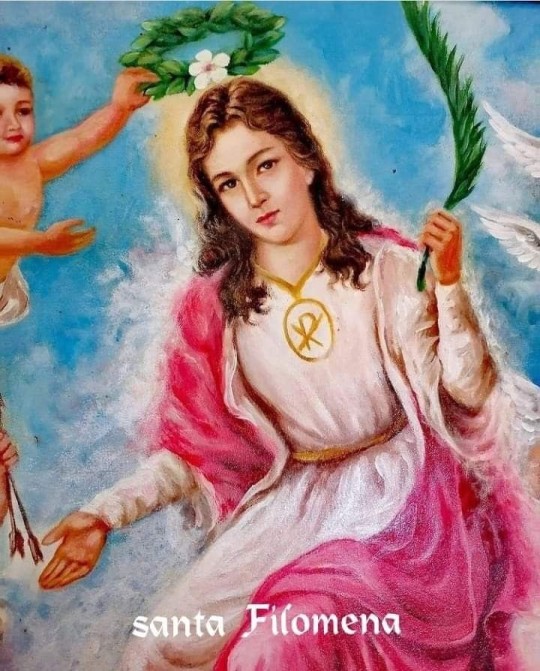

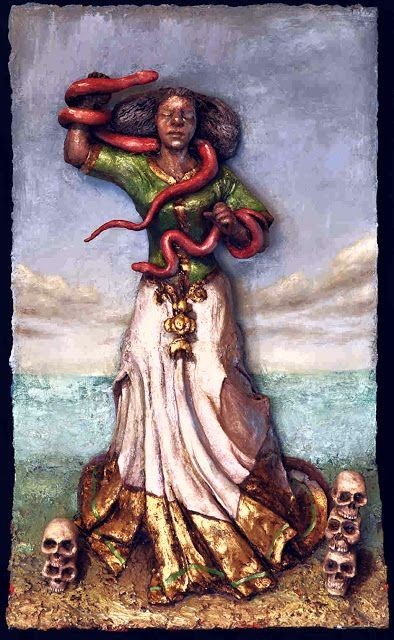
6 notes
·
View notes
Text
Antonio nuggles
#Antonio legba#Antonio gede#dominican vudú#called the guy for the va loan hes gonna get back to us later#gonna look at a couple more houses#so that means interview with a vampire (original) and nest with cuddles :P
0 notes
Text



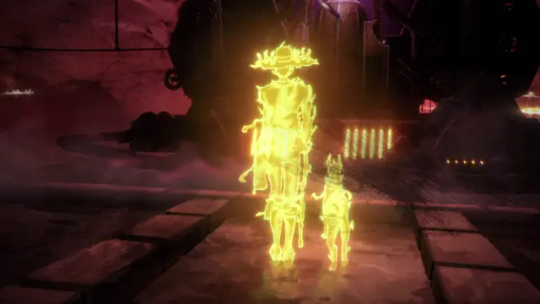
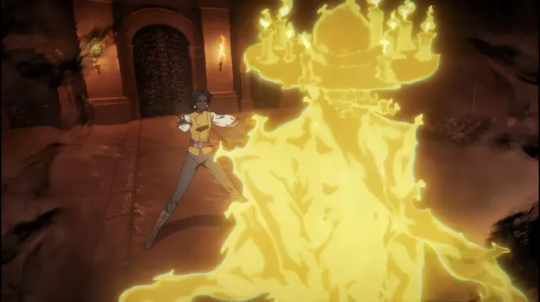


Black Vampires & Papa Legba
Annette (Haiti/Saint-Domingue) - Castlevania Nocturne Louis de Pointe du Lac (Haitian-Creole, New Orleans) - Interview with the Vampire
Papa Legba is a lwa, or loa, in West African Vodun and its diasporic derivatives (Dominican Republic Vudú, Haitian Vodou, Louisiana Voodoo, and Winti), who serves as the intermediary between God and humanity. He stands at a spiritual crossroads and gives (or denies) permission to speak with the spirits of Guineé, and is believed to speak all human languages. In Haiti, he is the great elocutioner. Legba facilitates communication, speech, and understanding. He is commonly associated with dogs. Papa Legba is invoked at the beginning of every ceremony. Papa Legba has his origins in the historic West African kingdom of Dahomey, located within present-day Benin. He usually appears as an old man on a crutch or with a cane, wearing a broad-brimmed straw hat and smoking a pipe, or drinking dark rum. The dog is sacred to him. Legba is syncretized with Saint Peter, Saint Lazarus, and Saint Anthony. His veve incorporates a walking cane on the right side. Offerings to him typically include candy. (Wikipedia)
In the Haitian religion of Vodou, Legba is seen as the intermediary between mortal men and the loa, or lwa. The loa are a group of spirits responsible for various aspects of daily life, and they are the children of a supreme creator, Bondye. They are divided into families, such as the Ghede and Ogou, and practitioners develop relationships with them through offerings, petitions, and prayers. Often, Papa Legba is the one who carries these prayers to the loa. (LearnReligions)
#castlevania nocturne#castlevania#interview with the vampire#louis de pointe du lac#iwtv tvc metas#black power#black history month#religion#louis de pointe du black
17 notes
·
View notes
Text
Worshipping Mother Mary
I am not Christian so I thought I'd write about my practice.

[Art: 12th Century Mosaic The Annunciation, Church of San Marco Venice]
◾️Mariolatry◾️
I use this word over "Marian Devotion / Veneration" It literally means "Worship of Mary." I use this term to distinguish it from Christianity. Latin Maria + o + -latry. Maria referring to Mother Mary, 'o' is an interfix, and "-latry" meaning 'worship of.' -latry according to wiktionary comes from Late Latin latria, from Ancient Greek λατρεία (latreía, "service; worship"). In Catholicism, the largest denomination of Christianity, worship is known as latria. It comes from the exact same origin "-latry" does and giving Mary latria is a sin.
Latria is due only to God (The Trinity) and God alone. Dulia, which comes from Greek δουλεία douleia meaning slavery/service to a lord, is the honor paid towards Saints. Hyperdulia, which is just dulia with a hyper prefix attached meaning "over", describes the honor paid towards Mary. It is above the honor of saints but below worship.
"Wherefore dulia, which pays due service to a human lord, is a distinct virtue from latria, which pays due service to the Lordship of God. It is, moreover, a species of observance, because by observance we honor all those who excel in dignity, while dulia properly speaking is the reverence of servants for their master, dulia being the Greek for servitude". — St. Thomas Aquinas
I am a polytheist so I do not ascribe to the belief that she deserves lesser honor while The Trinity alone deserves worship (latria).
The above was an edited excerpt of this post LINK, that goes a bit more in depth about terminology.
I originally found Mary as Our Lady of Sorrows via Las 21 Divisiones (Dominican Vudú), not Christianity. Metresili is syncretized with Mater Dolorosa's and as I learned about the practice I felt "drawn" to her. However, I found myself wishing to honor the Christian Saint Mary not the Vudú Lwa Metresili, so thats what I did. I shelved my exploration of Vudú as it has requirements I'll never be able to meet.
◾️Mary as a "Hero"◾️
I do not worship Mary as a Goddess. I worship her in the same mindset as the worship of heros by the ancient Greeks.
"Heroes can be distinguished from the less powerful dead by their extraordinary achievements, importance to and worship by an entire community or multiple communities, their powers to help or harm, and their privileged afterlife." — Hero Cult in Apollonius Rhodius by Sarah Hitch in Gods and Religion in Hellenistic Poetry. LINK
"For the ancient Greeks there was no clear-cut definition of a hero; still, heroes were distinguished from gods and from the ordinary dead. How we perceive a hero and his cult is dependent on which kind of evidence we consider. A hero can be defined as a person who had lived and died, either in myth or in real life, this being the main distinction between a god and a hero. He was thus dead and may have had a tomb, which sometimes was the focus of a cult, though not all heroes received religious attention. The difference between a hero and an ordinary dead person lies in the relationship with the living, the ordinary dead having some kind of connection with those tending the grave and presenting offerings, while the heroes were worshiped on a more official level. Finally, the hero was generally a local phenomenon and most heroes were connected with one specific location." — from Heros and Hero Cults by Gunnel Ekroth LINK

[Art: This Annunciation of 1892, by Arthur Hacker based on Gospel of James]
Mary has certainly taken on this distinction, not a Goddess but certainly not an average deceased person/ancestor. And in many cases her devotion takes on different forms in different locations and time. The rise of different titles, the various feast days of Mary, different locations of pilgrimage, spiritual Mother of certain groups, matron of certain activities, associated with holy relics, and associated with 'verified' miracles.
She is seen as a mortal woman who accomplished the amazing feat of bringing Jesus into the world and being his life long companion. People turn to her for divine intercession and miracles. In many Christian traditions she is certainly above all the "normal" deceased humans including even the saints.
◾️What She Means To Me◾️

[Art: 'The Madonna of the Roses' and 'The Madonna of Pietà' by William-Adolphe Bouguereau]
Her response during The Annunciation & Her Seven Sorrows are paramount in her meaning to me.
Mary answered "yes" when her God asked her to take on the most important role for humanity, Luke 1:34. After her conversation with Gabriel, beyond basic questions about it being physically possible her response, to this incredible responsibility her God was tasking her with, was simply: "I am the Lord's servant,' Mary answered. 'May your word to me be fulfilled.' Then the angel left her." (NIV translation).
Mary is the embodiment of piety.
Before her son was even one years old a respectable devout man told her a horrible prophecy of her son's greatness that will lead to her soul being pierced (Luke 2:25-37).
Mary is acceptance of painful things to come.
She fled to Egypt in order to protect her son (Matthew 2). She cherished her son fulfilling the prophecy even after her anxiety of losing him. (Luke 2:51) She suggests he preform his first miracle (John 1:5) knowing he is much more than just the son she loves. She has to watch her son be tortured by carrying the cross and be executed on a cross, helpless to stop it but simultaneously knowing this was always the destination.
Mary is strength in the face of tragedy.
She cared for Jesus deeply knowing all along that she would have to undergo great emotional pain but that her God had placed this responsibility on her, and her alone.
Mary is the epitome of spiritual devotion.
Her son raises from the dead, but that is brief and he ascends into heaven... leaving her behind, her role during life was complete and her son was not coming back to her. If we take from non-canonical biblical sources she was a constant companion to her son in life and continues his work after his death and ascension.
Mary is the ability to accept grief.
◾️Historicity ◾️
Historicity is the historical actuality of persons and events, meaning the quality of being part of history instead of being a historical myth, legend, or fiction. The historicity of a claim about the past is its factual status. Historicity denotes historical actuality, authenticity, factuality and focuses on the true value of knowledge claims about the past. — Wikipedia LINK
She may have been a mortal woman, but her historicity doesn't concern me. Wheather or not she was a real woman—born of Anne and Joachim, in the tribe of Judah or Levi, with a relative named Elizabeth, and gave birth in a manger or house— in real factual history is irrelevant. In a similar vein the tales of Greek heros need not be historical factual truth to carry religious meaning and importance.
I do not believe in the historicity of Sacred Scripture thus her stories in the canonical New Testament, Quran, and Christian apocrypha I view in the same light as the literary Epics of heros describing their life, accomplishments, and character. I write more about the nature of Sacred Scripture here LINK.
◾️Mary's Titles I Worship◾️
I view the multitude of "Our Lady of ___" as all the same person but like many I give her honor under different names and roles.
🔹Our Lady of Sorrows, Mater Dolorosa. The Virgin Mary in her aspect of the suffering she endured as the person to bring Jesus (The Savior) into the world. This is the main focus of my worship. There are seven sorrows she faces. I switch between calling her Our Lady of Sorrows and Mater Dolorosa kind of at random.

[Photo: Our Lady of Sorrows with 7 Swords, Church of the Holy Cross, Salamanca, Spain]
Additionally I may worship her under the titles:
🔹Our Lady of Altagracia, Nuestra Señora de la Altagracia. Protective and Spiritual Mother of the Dominican People. Feast Day January 21st.

[Photo: from a mass to Our Lady of Altagracia, unknown location, found on blog link]
🔹Our Lady of Solitude as it is a title of Mary that relates to Our Lady of Sorrow— an 8th sorrow almost, it is Mary when she retreats into solitude after Jesus crucifixion but before Jesus' resurrection. Honored in many Spanish & Portuguese speaking countries. Feast Day is Holy Saturday.

[Photo: Our Lady of Solitude at the Basilica of Our Lady and Saint Anthony of Mafra]
◾️Worshipping◾️
Mary's Worship is separate from my Sumerian-Hellenic polytheist tradition. Despite being founded on the viewpoint of Hellenic heros it feels better separate.
Things I find relevant when developing my practice:
🔹Literature: Passages in the canonical Gospels; passages in the non-canonical Gospels; Christian apocrypha of Mary's life; other Christian writings concerning Mary. The Quranic Mary is so different in story that I don't take it into account thus far.
🔹Edited prayers: I tend to edit prayers so that they focus more on Mary and her strength, rather than focusing on asking Mary to intercede on our behalf with God/The Trinity or bring us closer to her son Jesus.
🔹History of her honor: The history of feast days, the stories behind certain titles, the history of miracles, even heretical practices criticized by Christians if I feel it works
🔹Roman Catholic traditions primarily because they are easily accessible and I went to Irish Catholic school K-8, and experienced Latino style Catholicism in one of my childhood homes. This includes feast days dates.
🔹Occasionally other denominations traditions especially Eastern & Oriental Orthodox. This may include using alternative feast day dates.
Actual Practices:
🔹Prayers thats pretty straight forward.
🔹Seven Sorrows Rosary, I use the shortened prayer for each or may edit the longer ones one day. Found here LINK

[My Rosary from World Visions International]
🔹Honoring the Sorrows Across The Year

[Art: 16th Century Unknown Artists (as far as I can find)]
Sorrow 1: Prophecy of Simeon. Candlemas. February 2nd.
Sorrow 2: Flight into Egypt. February 17, Roman Catholic Missal.
Sorrow 3: Losing Child Jesus. 3 Days after Passover.
Sorrow 4-7: All dealing with the Crucifixion. Good Friday.
Our Lady of Sorrows Feast Day September 15.
🔹Other Feast Days I might consider celebrating if I'm up for it: The Annunciation (Feb 25), Marymas (Sep 8), Our Lady of Altagracia Feast Day (Jan 21), Our Lady of Solitude Feast Day (Holy Saturday).
🔹"Collyridian Offering", what I am calling the offering of sweet bread (Koulourakia or Koulouri would be best, but I have gluten sensitivity). Either at each special day or at least once a year on Mater Dolorosa's Feast Day of Sep 15. This comes directly from a (possibly) historical heretical practice I discussed here LINK.
🔹Marian Shrine. What it sounds like, a Shrine to Mary. I use my KJV Bible because it's gorgeous even though I know the Bible best via the NIV translation and usually only use NIV for writing. I use a saint candle like those I used as a kid in Latino Catholism. If I have one set up I may keep my rosary there as well as printed prayers.
#marian veneration#marian devotion#mary worship#virgin mary#mary mother of god#mariolatry#polytheism#my practice#our lady of sorrows#marian art#religion#spirituality
15 notes
·
View notes
Text
I’m still mulling this over, but I might reverse the decision to remove Lady Rose from the lineup.
What’s sticking in my brain is the description of “Mama You”...Upon further investigation, it does seem that “Manman Ou” is used in reference to lwa in the Ezili famille - especially Ezili Danto (Manman Danto), but not so much Ezili Freda. You can find examples of this all over the internet. I guess what I said wasn’t entirely stupid!
“Mama You” is specified as “the mother of the child Jesus”, not just “the Virgin Mary”.
Ezili Freda and Ezili Danto are both represented by images of the Virgin Mary, but Freda is represented by Mater Dolorosa - Our Lady of Sorrows, without the child Jesus - while Danto is represented by the Black Madonna - a maternal figure with the child Jesus on her wrist.
El vodú en Cuba by Joel James Figarola, José Millet, and Alexis Alarcón captures how Vodou (Vodú) was practiced by the descendants of Haitians who emigrated to Cuba during first half of the 20th century*. Two different Ezili (Ercilí) were worshiped: one described as “Rada” and one described as “Petro”:
“Hemos podido registrar dos tipos de Ercilí en nuestras investigaciones de campo: una, de claro sello radá y otra, que bien puede equipararse con la Ercilí-Yeux-Rouges (Erzulie Ojos Rojos), de tipo petró (Courlander, 1985: 319).”
MACHINE TRANSLATION:
“We have been able to record two types of Ercilí in our field investigations: one, with a clear Radá seal and another, which can easily be compared to the Ercilí-Yeux-Rouges (Red-Eyed Erzulie), of the petró type (Courlander, 1985: 319).”
SOURCE: James Figarola, Joel, et al. El vodú en Cuba. Santiago de Cuba, Editorial Oriente, 2007. Originally published in 1998. p. 171
Likewise, “Petro” and “Rada” forms of Ezili (Esili) are observed in Dominican Vudú, though it is unclear whether they were considered separate beings or two sides of a single being. I am also unclear on the timeframe for this observation, as I was unable to obtain a copy of Martha Ellen Davis’ (1987) La otra ciencia: el vodu como religion y medicina populares. (In the present day, Metresili is distinct from Esili Dantor)
“En República Dominicana, esta divinidad recibe el nombre de Metré Silí y tiene gran renombre. Posee muchos de los trazos de la divinidad haitiana: es muy débil a los perfumes, a las prendas y a los trajes lujosos y caros. Odia la bebida y se deja arrastrar por la atracción masculina (Deive, 1975: 185). Esta misma divinidad, en punto petró, es “la única metresa que se presta para recoger corrientes malas [...] cuando utiliza flores amarillas o de sol [...]” (Davis, 1987, 242)”
MACHINE TRANSLATION:
“In the Dominican Republic, this deity is called Metré Silí and is very well-known. She has many of the traits of the Haitian deity: she is very weak to perfumes, clothes and luxurious and expensive suits. She hates drink and lets herself be carried away by male attraction (Deive, 1975: 185). This same deity, in petró point, is “the only metresa that lends itself to collecting bad currents [...] when she uses yellow or sun flowers [...]” (Davis, 1987, 242)”
SOURCE: James Figarola, Joel, et al. El vodú en Cuba. Santiago de Cuba, Editorial Oriente, 2007. Originally published in 1998. p. 171
*see: Anderson, Jeffrey E.. Voodoo: An African American Religion. United States, LSU Press, 2024. p. 64.
Ezili Danto is said to emerge in 1791, at Bwa Kayiman. Really going out on a limb here, but what if the symbol resembling Ezili Freda’s veve* is evidence that Ezili Freda was worshiped, while the reference to “Mama You” is evidence that Ezili Danto was worshiped as an independent divinity from Ezili Freda…?
*see page 31 of: Cole, Kendra, "The State and the Spirits: Voodoo and Religious Repression in Jim Crow New Orleans" (2019). Honors Theses. 658. https://aquila.usm.edu/honors_theses/658
Or, rather Danto specifically, one of the Petwo Ezili…? Alternatively, “Mama You” might be “Manman Wou”, who is listed as one of the lwa in the Ezili famille.
Of course, this is just a theory, and it doesn’t have strong evidence… This is literally just real-life fanfiction!
I would not go down this road if this was a story based in the real world, as the evidence here is so weak. But it seems no matter what decision is made, it inevitably becomes an exercise in interpretation and “guessing”, since the historical record is so sparse.
There is an advantage to making “Lady Rose” and “Lady Love” twins… Twins hold a spiritual significance in West African belief systems. In Dahomean Narrative, several of Legba’s older siblings are twins. In Haitian Vodou, a pair of divine twins features prominently: The Marassa. It is fitting for a couple of “The Seven” to be a pair of twins…
“Lady Rose” is Black like “Lady Love” because, from a visual standpoint, it gets too confusing if “The Seven” don’t have the same skintone. This is a deliberate departure from the real-life counterparts, and not a decision I would have made if the story was set in the real world.
In a sense, “Lady Rose” has a dagger in her heart, not over the loss of a child but the loss of her twin sister. Two sisters who were once inseparable, now bitter enemies…
(it’s basically the female version of Gravity Falls…)
Naturally, I plan to develop multiple, parallel concepts that could be swapped for each other, like so:
“Lady Rose” and “Lady Love” as twins
“Lady Rose” is removed; her image is what “Lady Love” used to look like
Same as 2, but elements of Ezili Danto / Black Madonna of Częstochowa are removed
Just a question of which one should occupy the no.1 spot, and which one should be listed as an alternative…
So I’m leaning towards reversing my decision, but I need to think about this a little harder… There are pros and cons to each option, which is why all should be developed further, in parallel…
#commentary#i have more to say about this but it will have to wait for another time...#lady love (hazbin hotel)#lady rose (hazbin hotel)#the loa (hazbin hotel)
2 notes
·
View notes
Text
Spiritual Church of New Orleans/Black Spiritual Church movement.
Let's discuss The spiritual churches of New Orleans and the black spiritual church movement. I love to sharing about Spirtualism on this Blog because I define myself as an African American spiritualist, Soulaani spiritualism if you will, which is distinct from American spiritualism which was predominantly practiced by white upper class people across the United States.
Spiritualism is a religion that began in New York with the fox sisters during the Reformation movement, this new religious phenomena spread quickly to the Soulaani community as spiritualism mirrored many of the ancestral practices of many colonized BIPOC spiritual traditions that had been phased out. Trans-cultural parallels show a similar happening in Latin America through the adoption of Espiritismo, a Kardecist perspective on Spiritualism.
The spiritual church movement in the African American community is largely attributed to Mother Leafy Anderson, a medium from Wisconsin who relocated to New Orleans where she demonstrated her mediumistic ability and wisdom through the channeling one of spirit guides Blackhawk, Aunt Esther, and many more.
These uniquely Black spiritual churches became a cornerstone in the black community as an alternative to more mainstream beliefs held in our communities and also were there with open arms to receive black members who were expelled by the national spiritualist association of churches in the '20s during Jim Crow causing their growth even further. By the mid-1920s you could find black spiritual churches in the New Orleans tradition from Chicago, Detroit, California and Texas.
This unique tradition is characterized by its blending of Catholic iconography, with a Pentecostal or Baptist worship style. Some congregations even purported to incorporate elements of Conjure, Hoodoo and Voodoo(not to be confused with Haitian Vodou, Dominican Vudú, or Vodun) such as in the case of mother Catherine seals, an eccentric healer who was said to have healed herself back from the dead. Not many of the churches still stand, however, some noteworthy and historic ones include The metropolitan Spiritual Church of Christ, Pentecostal spiritual Assemblies of Christ, universal hagar's spiritual Church. And many many more!
6 notes
·
View notes
Text
I remember doing ceremonies with my cousins
I remember my inititiations back in 2003
I was initiated into Palo in 2003
I was initiated into Santeria in 2004
I was initiated into Dominican vudú and Haitian voudou in 2010
I was initiated into Umbanda in 2011 by 13-14 i was at my limit for being in my energy vampire household and the discussions of which new house started.
0 notes
Note
4, 14 and 17 for lovely Syn?
Of course!
4. In developing their backstory, what elements of the world they live in played the most influential parts?
a. Syn's rejection of Catholicism, stemming from the death of their father and a sexual assault in Catholic school in their teens by a male classmate . Their father was mistakenly gunned down by NYC cops during a manhunt for an escaped prison convict as he walked home from work one night after double shifts as a security guard. Syn was devasted as he was the only parent they had left (their mother died in childbirth).
The final "nail in the coffin" was seeing that same cop exit a confessional the next night after mass and later finding him back on the street as if nothing had happened with no punishment and no apologies - same as the male classmate who smirked at them on returning to class after only a day suspension and "absolution" from a school priest.
Enraged, Syn denounced the Church and flew down to the DR (Dominican Republic) to get away and connect with any members of their father's family and found his grandmother and aunt who introduced Syn to the Vudú traditions their father had left behind decades ago. Traditions of an old branch of vodou that originated from neighboring Haiti.
b. Syn's rise in the criminal underground. Syn returned to NYC (Brooklyn) from the DR after a year's stay with their grandmother and moved into a shelter. They earned a small amount of money fixing the computers of the shelter staff, becoming such an asset, they turned a closet into a makeshift tiny office where they could manage the IT work for the small Brooklyn shelter. Long story short, Syn learned to dissect and defang malware and wrote software neutralizing infections (the shelter couldn't afford subscription AntiViral software). Syn's work caught the eye of a Cobra online who offered a better job and…so much more.
14. If you had to narrow it down to 2 things that you MUST keep in mind while working with your OC, what would those things be?
I keep in mind their:
1) Extreme Rage
2) Need for Vengeance which is all consuming when they're triggered (Flaw). Syn's personal Vengeance was never satisfied and festered pre-Embrace…but after their Embrace into the Serpents of the Light, their Beast became the incarnation of that Vengeance with an almost separate identity so much so that one could say that Syn and their Beast are a plural system.
17. Is there some element you regret adding to your OC or their story?
Adding a sexual assault (i.e. rape) to their back story, but it is the source of their simmering incandescent rage that they weaponize against anyone, Cainite or kine (which they kill outright if they're crossed). Looking back, it's an extremely vulnerable moment, but it makes Syn what they are..extremely focused and lethal, having a pair of venomous Cobra fangs (Serpentis 6) (their sire is a 6th gen who follows them back from the DR pre-Embrace..shadowing and watching Syn until direct contact on the darknet with an offer...)
Syn (she/they) has a baggage of misery, pain, anger and talent and a direct descendant of a long line of DR vudú practitioners - prime candidate for Embrace and initiate into the secrets of the Path of Ecstasy.
1 note
·
View note
Text
Different Styles Of Voodoo
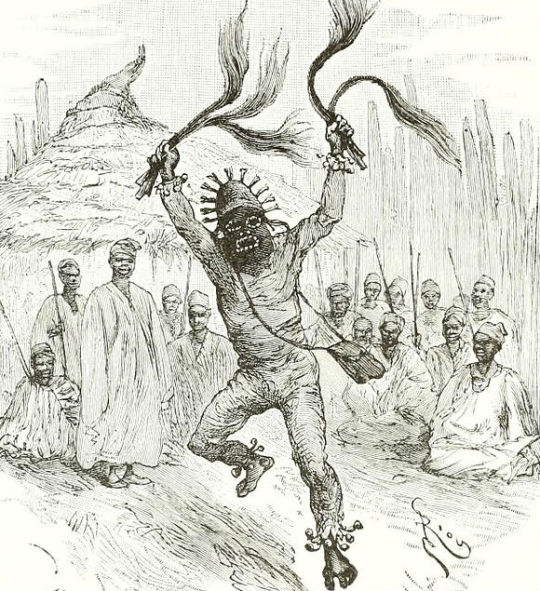
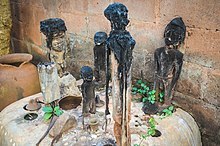
When I hear that a country or city don't practice real Vaudou aka voodoo it bothers me when that person don't really know what voodoo, Vodou, Vodun etc is. Some think that it started in Haiti or that it isn't real if your not initiated in Haiti. So I wanted to make this quick post to show a few of the different styles of voodoo there are. Do the proper research and choose which practice calls to you.

First up is African Vodun is an is the birth place of vodun a ancient religion practiced by some 30 million people in the West African nations of Benin, Togo and Ghana. With its countless deities, animal sacrifice and spirit possession, voodoo — as it's known to the rest of the world — is one of the most misunderstood religions on the globe.

Second Haitian Vodou is an African diasporic religion that developed in Haiti. It arose through a process of syncretism between several traditional religions of West and Central Africa and Roman Catholicism. Vodou revolves around spirits known as lwa. Typically deriving their names and attributes from traditional West and Central African divinities, they are equated with Roman Catholic saints and the central ritual involves practitioners drumming, singing, and dancing to encourage a lwa to possess one of their members and thus communicate with them.
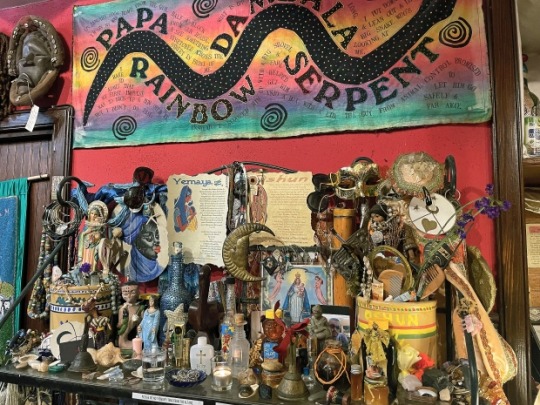
Third. Louisiana Voodoo, also known as New Orleans Voodoo, is an African diasporic religion which originated in Louisiana, now in the southern United States. It arose through a process of syncretism between the traditional religions of West Africa, Haitian Vodou and some christianity.


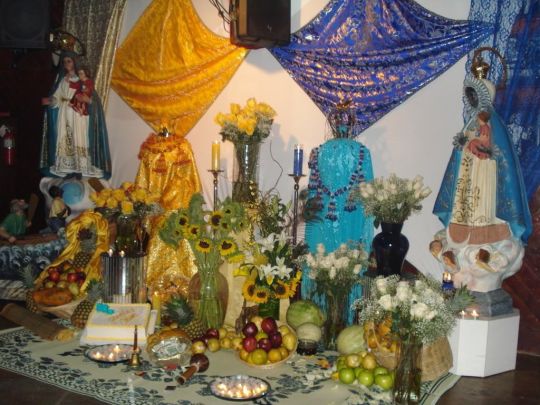
Forth Santería, also known as Regla de Ocha, Regla Lucumí, or Lucumí, is an African diasporic religion that developed in Cuba during the late 19th century. It arose through a process of syncretism between the traditional Yoruba religion of West Africa, the Catholic form of Christianity, and Spiritism. This is the same as the Ifa in Africa except they use saints also
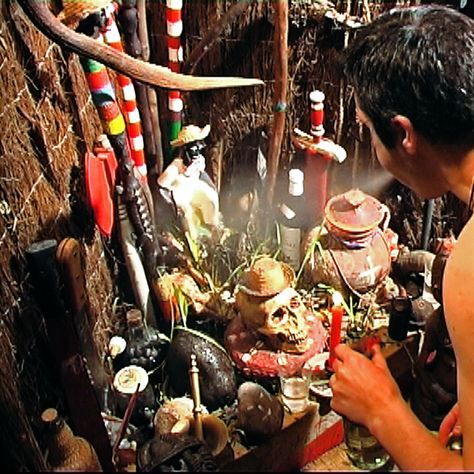

Fifth Palo: also known as Las Reglas de Congo, is an African diasporic religion that developed in Cuba. This is the first practice that hit first before Santeria. It arose through a process of syncretism between the traditional Kongo religion of Central Africa, the Roman Catholic branch of Christianity, and Spiritism.
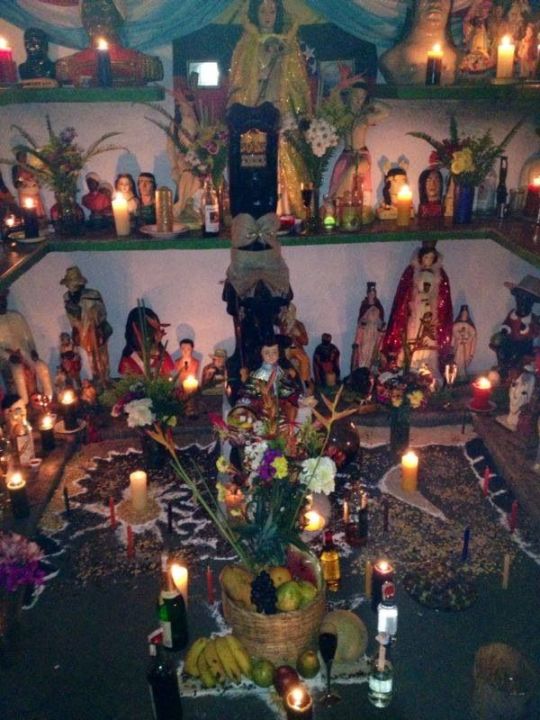
Sixth Espiritismo: Spiritism. Espiritismo (Spiritism) is rooted in the belief system that the spirit world can intervene in the human world and is widely practiced in Puerto Rico it not voodoo but I wanted to add it. At its most basic level, it invokes God and The Positive Spirits to divine for and assist the person. There is the use of a table covered with a white cloth, a large bowl full of water, and a crucifix. There are no initiations into this tradition and people work together at gatherings called Misas.
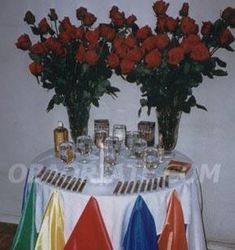
Seventh Sanse: Sanse is a cross between Spiritism and the 21 Divisions. In this tradition, the dead and the Lwa (or Misterios) are worked with spiritually. There is an initiation called a Bautizo (Baptism) and people work withall sorts of different spiritual tableaus, or frameworks.

Eight. Obeah, or Obayi, is a series of African diasporic spell-casting and healing traditions found in the former British colonies of the Caribbean. These traditions derive much from traditional West African practices that have undergone cultural creolization.
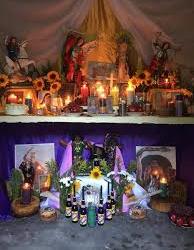
Ninth. Dominican Vudú, known as Las 21 Divisiones (The 21 Divisions), is a heavily Catholicized syncretic shamanistic religion of African-Caribbean origin which developed in the erstwhile Spanish colony of Santo Domingo on the island of Hispaniola. Now 21 Divisiones/Dominican vudu is very similar to the tchatcha/kwakwa/Deka lineage in Haiti. In 21 Divisiones and in the tchatcha lineage of Haitian vodou, is the north part of Hati and the initiations are different and the temples are organized differently.
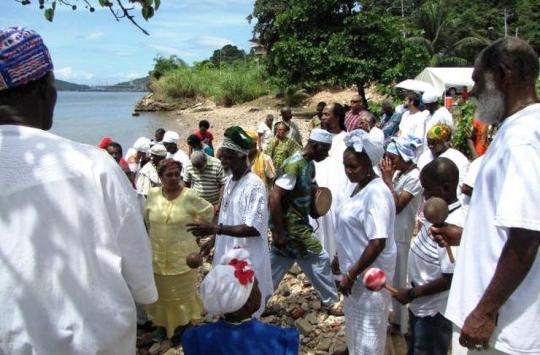

Tenth. Trinidad Orisha, also known as Shango, is a syncretic religion in Trinidad and Tobago and the Caribbean, originally from West Africa.
I these are some of the voodoo style practices around the world .
#Types of voodoo#African practices#Voodoo#Vodou#Vodun#Spiritual#Voodoo Styles#Different voodoo#Voodoo styles#follow my blog#ask me anything#ask me stuff#like or reblog#like and comment#Spiritual information
52 notes
·
View notes
Note
not sure how to phrase this question so forgive me if the wording is awkward please but i think you mentioned voodoo is a closed practice once and i wanted to know who is the group to whom it belongs? like kabbalah is closed because its a jewish thing, and people who are not jewish should not do it. who's thing is voodoo?
Voodoo is an African Diasporic Religion unique to the black population of Louisiana. It is related to but distinct from it's relatives like Cuban Vodú, Hatian Vodou, and Dominican Vudú, all sequestered to their respective populations.
Also related is Hoodoo, also known as Rootwork, or Low Country Voodoo, which has its roots in the South Carolina Low-Country.
239 notes
·
View notes
Photo

Differences from voodoo religions
Hoodoo shows evident links to the practices and beliefs of Fon and Ewe Vodun spiritual folkways. The folkway of Vodun is a more standardized and widely dispersed spiritual practice than Hoodoo. Vodun's modern form is practiced across West Africa in the nations of Benin, Togo, and Burkina Faso, among others. In the Americas, the worship of the Vodoun loa is syncretized with Roman Catholic saints. The Vodou of Haiti, Voodoo of Louisiana, Vodú of Cuba, and the Vudú of the Dominican Republic are related more to Vodun than to Hoodoo. Archeologists unearthed Hoodoo artifacts on slave plantations in Maryland showing evidence of West African practices in the United States brought over by African slaves.

On another plantation in Maryland archeologists unearthed artifacts that showed a blend of West African and Christian spiritual practices among the slaves. This was Ezekial's Wheel in the bible that blended with the Central African Kongo cosmogram. The Kongo cosmogram is an x enclosed in a circle that resembles the Christian cross. This may explain the connection enslaved black Americans had with the Christian symbol the cross as it resembled their African symbol.
140 notes
·
View notes
Text

https://www.readersandrootworkers.org/wiki/Nsasi
#voudou#santeria#loa#lwa#obatala#papa damballa#umbanda#ayida weddo#sorry bawon samedi#haitian voudo#we dont talk about the french#dominican vudú#pickles the drummer#dominican voodoo#palo mayombe
3 notes
·
View notes
Photo

♀ I Politically + Ancestrally [PA] Freed Moor of Us [U.S. = ABORIGINAL] Black American Spirit [BAS = ORISHA] Earth Indians back 2 Louisiana’s Ancient [L.A.] Afro American Confederation of Cosmic Allegiance [CA] Forces who Always Universally + Spiritually Assist [U.S.A.] + Magically Enforce [ME = U.S. Michael Harrell = TUT = JAH] My NEW… Nubian Worldwide Order [NWO] Government of SIRIUS Black Revolutionary Haitian Afterlife [HA = HARRELL] Souls from Lost Atlantis [L.A.] ♀
#U.S. Michael Harrell#U.S. King TUT of Celestial Atlantis [CA]#Toussaint O'Luverture Bloodline Intelligences#Mama's Ubiquitous Secret [U.S.] African Moukouji Society of Ancient [SA] Punu Tribes#Black American Haitian Bloodlines#Reincarnated Celestial American [CA] Spirits of Haitian + Dominican Vudú Bloodlines#Magical Afro Caribbean [MAC] Religions of Santeria Haitian Voodoo Sciences#Heavenly Father’s SIRIUS Black Hyperion Airwave Intel Technologies of Interstellar Afterlife Nuclei [HAITIAN] Bloodlines#Native Black American Indians from Louisiana’s Afro [L.A.] American Confederation of Cosmic Allegiance [CA] Forces#U.S. Double Black White House Illuminati#My ORIGINAL… Prehistorically FUTURISTIC U.S. Afro American Indian Empire of Golden Afterlife [GA = ROMAN] Egyptians#Shadow Government Illuminati#My Golden Black California Afterlife [CA] Illuminati of Lost Atlantis [L.A.]#My NEW Nubian Worldwide Order [NWO] Government of SIRIUS Black Revolutionary Haitian Afterlife [HA = HARRELL] Souls of Lost Atlantis [L.A.]#I Politically + Ancestrally [PA] Freed Moor of Us [U.S. = ABORIGINAL] Black American Spirit [BAS = ORISHA] Earth Indians from Louisiana#Louisiana’s Ancient [L.A.] Afro American Confederation of Cosmic Allegiance [CA] Forces#My GOLDEN [DIVINE] Black Louisiana Purchase Magick
1 note
·
View note
Text
Dominican Vudú
Last edited 2019-07-06
Articles
* Cardeña, Etzel and Yvonne Schaffler. “’He Who Has the Spirits Must Work a Lot’: A Psycho-Anthropological Account of Spirit Possession in the Dominican Republic.” Ethos: Journal of the Society for Psychological Anthropology 46, no. 4 (December 2018): 457-476.
2 notes
·
View notes
Text
People in Las 21 Divisiones
Excerpt from: The 21 Divisions Mysteries & Magic of Dominican Voodoo by Papa Hector Salva 21 Divisions Espiritismo Brujo. Page 8-10. Spanish is marked with blue font. This is all quotes except the headers; not my writing.
🔸Humanity🔸
Everyone is born with a Guardian Misterio. This Misterio is assigned to you by God , like your guardian angel , and is meant to guide, protect, and help you. Likewise each individual is born with a certain amount of spiritual power (fuerza), which varies from person to person. It is this power that determines the degree or level of connection to and awareness of the spiritual world. Some individuals are born with such power and connection that they are able to communicate and have a relationship with the Misterios. The path of the 21 Divisions is initiatory / apprenticeship oriented and has a hierarchical structure. In other words, on the Dominican Voodoo path, one has a spiritual teacher, guide, and parent , who is known as a Madrina / Mama (female) or Padrino / Papa (male). There are levels of initiation and processes of apprenticeship that happen to develop fuerza and connection to it .
🔸Believer / Follower🔸
A believer and follower of the Misterios is known as a devoto, or devotee. This is a person who believes and follows the Misterios, but without the ability to work with the Misterios or have open communication with them. The Misterios protect and bless their devotos, interceding and helping them when there are issues. A devoto, however, will have a brujo, or priest, to go to in order to receive the guidance of the Misterios.
🔸Practitioner / Servant🔸
A practitioner of the 21 Divisions is known as a servidor de Misterio , a servant of the Mystery. Females are known as servidoras. First and foremost, the person is servant to the Greatest Mystery, God, and after God, his Divine Mysteries of Light, the Misterios of the 21 Divisions. Through his connection to the spiritual world and serving the Misterios, the servant comes closer to God and the Lwases, which brings blessings, protection, health, and good luck. Aside from these worldly goals, a practitioner will also be able to develop spiritual gifts, powers, and abilities, attaining greater and greater spiritual progress. Servidores who have the fuerza and illuminated connection are able to work with the Misterios to varying degrees. However, most servidores' powers are limited usually to him or herself and the closest loved ones. Their spirituality and spiritual powers are for their own benefit and to improve their own lives. Such servidores may or may not be initiated. However, initiation develops the servidores' spiritual gifts and abilities, as well as giving them greater connection to their Misterios. Either way, they will always have a Padrino or brujo from whom they receive guidance and help when it comes to their spiritual path.
🔸Priest🔸
A brujo (male) or bruja (female) is a priest of the 21 Divisions. He or she can affect the physical world , their own life, and the lives of others through various offerings, rituals, and ceremonies, which are often called services or servicios. For simplicity's sake, I will use brujo overall in our discussions. He has Misterios Trabajar or Mysteries for Working for others. By working with the para Misterios, a brujo can be a vehicle for Divine healing, help, and guidance to themselves and others. The brujo dedicates himself to the development of his spiritual power and connection with the Misterios. Thus he is able to work and manipulate the power in order to make miracles. Magic is a central element of the practice and can be used to attract luck, love, success, and many of one's goals and aims.
🔸Initiated Priest🔸
An initiated brujo of Dominican Voodoo is known as a Papa Boko. An initiated bruja is a Mama Mambo. They have received the secret rituals and wisdom that have been passed down through the centuries in a sacred lineage from master brujos to students. Not all brujos undergo initiation .
#las 21 divisiones#dominican vudú#dominican voodoo#cultural appreciation#hector salva#The 21 Divisions Mysteries & Magic of Dominican Voodoo#michibooks#quote pile#yes this is literally just all a quote that i broke up with colors and stuff#because its interesting#author is a initiated brujo#im reading and wanted to share
3 notes
·
View notes
Text
African Traditional Religions
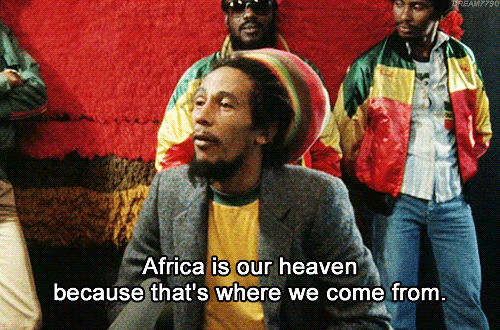
I see a lot of references to and posts about Vodou and Santería online, but there are so many more African traditional religions (ATRs) that almost never get discussed! For anyone of African descent who wants to learn more about the diverse set of African-based traditions around the world, here’s a still incomplete but much longer list. If any information is incorrect, message me.
AFRICAN RELIGIONS & CULTURAL APPROPRIATION
🔴Closed | 🔶Semi-Closed/Initiatory | ✅Open
The vast majority of ATRs are semi-closed/initiatory, meaning that you cannot fully engage with and practice the religion without being initiated into it or at least joining an in-person community of initiated practitioners. Some of these communities will choose to initiate people regardless of their ancestry or race and some will not. The only way to find out is to respectfully find a community of practitioners and ask about the possibility, but if the answer is no then it’s no. If you are a part of the culture and/or have a significant amount of heritage from the group that developed the religion, it’s okay to worship/interact so long as you do so in a way that’s appropriate for non-initiates. If you aren’t initiated, aren’t a part of the culture, and don’t have any heritage related to it, please treat it as a completely closed religion!
RASTAFARI
➡ Abrahamic, monotheistic, originated in Jamaica
🔴Closed religion, must be of African descent to practice
An Abrahamic spirituality that developed in Jamaica during the 1930′s, Rastas don’t refer to their faith as a religion or “-ism” because that would be contrary to its core ideas. They worship one God, whom they call Jah, and many regard Haile Selassie, the former emperor of Ethiopia, as a messiah. As an Afrocentric movement, Rastafari focuses on the African diaspora and the oppression of black people in Western societies. They refer to Western Society as Babylon and Ethiopia or Africa as a whole as the Promised Land of Zion. Smoking cannabis, wearing dreadlocks, and living naturally are all a part of livity, which is what they call the Rasta lifestyle and sacred practices.
YORUBA IFÁ
➡ Indigenous, shamanism, diffused monotheism, originated in West Africa
🔶Initiatory for everyone, partially open only to those of African descent
A form of West African indigenous shamanism. Many thousands of years ago, the Yoruba people of West Africa (primarily in Nigeria) developed an oral tradition and sacred literature called Ifá, which through the slave trade would become the origin of many diasporic ATRs around the world. Worship of the orishas as well as olorisha, babalawo, and iyalawo/iyanifa all come from the Yoruba people’s Ifá traditions in West Africa. The orishas are spirits of nature representing certain personalities and divine powers of the one supreme deity Olodumare. Though many people in the US practice Santería, there are also plenty who choose to practice Ifá traditions the Yoruba way and even fly to Nigeria to be initiated by Yoruba priests.
SANTERÍA/LUCUMÍ
➡ Afro-Cuban, Catholic syncretism, shamanism, diffused monotheism
🔶Initiatory for everyone, partially open only to Africana/Latinx people
Also called La Regla de Ocha (”Way of the Saints”), Santería developed as a distinct Afro-Cuban religion when the slave trade brought many Yoruba people practicing Ifá traditions to Cuba. Those Yoruba descendants in Cuba became the Lucumí people, who developed their own version of the religion syncretized with Catholicism. Most slaves were forced to practice Catholicism, and so pretending to worship saints was a survival tactic to preserve ancestral traditions in a new form. Santería is still widely practiced in Cuba, the US, and many other parts of the world.
PALO
➡ Afro-Cuban, Catholic syncretism, animism
🔶Initiatory for everyone, partially open only to Africana/Latinx people
Also called Las Reglas de Congo (”Ways of the Congo”), Palo is another Afro-Cuban religion with several different denominations including Monte, Mayombe, Briyumba, and Kimbisa. While many ATRs are derived mostly from West African traditions, Palo's roots are in Central Africa and the Congo Basin. Developed by the ancestors of many Kongo slaves brought to Cuba, Palo's liturgical language is a mix of Spanish and Bantu languages called habla Congo or lengua. Palo Cristiano are practitioners who syncretize with Catholicism and Palo Judio are those who do not. The Kimpungulu and Zambi are worshipped not orishas.
CANDOMBLÉ
➡ Afro-Brazilian, Catholic syncretism, shamanism, diffused monotheism
🔶Initiatory for everyone, partially open only to Africana/Latinx people
An Afro-Brazilian faith derived from Yoruba Ifá traditions as well as Fon and Bantu practices. The way Santería developed in Cuba out of Yoruba Ifá practices through the slave trade is very similar to how Candomblé became a distinct religion in Brazil. Like Santería, Candomblé is also blended with Catholicism, using saints as covers for the worship of African deities. Some noticeable differences between Santería and Candomblé include the orisha Nana Buruku and unique Brazilian terminology and spellings (i.e. orixa).
WEST AFRICAN VODOU
➡ Indigenous, shamanism, diffused monotheism, originated in West Africa
🔶Initiatory for everyone, partially open only to African descent
Acceptable spellings of Vodou include Vodun, Vodon, Vodoun, Vodou, and Voudou (not “voodoo”). It is the traditional religion of many West African cultures including the Fon, Ewe, and Kabye peoples. Vodou has many similarities to Yoruba Ifá in that spirits called the loa or lwa similar to orishas are worshipped who represent the natural divine powers of one supreme deity called Mawu or Mahu similar to Olodumare. Some loa and orishas are similar or even nearly identical, but Vodou beliefs and practices with the loa are very different and particular to the religion’s traditions. West African Vodou also spread through the slave trade around the world and became the originating religion for many diasporic traditions. It is possible to travel to Benin or other countries to be initiated into Vodou by an Africa priest or priestess, so West African Vodou is practiced primarily in West Africa but also worldwide.
GLOBAL DIASPORIC VODOU RELIGIONS
➡ Haitian Vodou, Dominican Vudú, Cuban Vodú, Brazilian Vodum
🔶Initiatory for everyone, partially open only to Africana/Latinx people
As listed above, West African Vodou spread around the world and developed into many different diasporic traditions just as Santería and Candomblé developed from Yoruba Ifá traditions. The most well-known diasporic branch is Haitian Vodou, where the religion’s formation by African slaves in Haiti also played a role in helping liberate the nation from French colonial rule. However, Vodou can also be found in the Dominican Republic, Cuba, Brazil, and the United States (particularly Louisiana where the term Voodoo is also popular). Across the many different diasporic Vodou traditions, Catholic syncretism and using the saints as a cover for worshipping loa is also significant.
KEMETICISM & KEMETIC ORTHODOXY
➡ Reconstructed, polytheistic, monolatry, originated in Northern Africa
✅Kemeticism is open, but Kemetic Orthodoxy has a conversion process
Kemeticism is the modern reconstruction of the religious traditions of Ancient Egypt. Kemetic Orthodoxy is a specific tradition of Kemeticism, which was founded by Rev. Tamra L. Siuda in the late 1980′s. Their official website says, “Kemetic Orthodoxy is an African Traditional Religion, and bears similarity to other African Traditional and African Diasporic religions (such as the West African religions of the Yoruba, Akan, Congo, and Dahomeyan peoples; and Afro-Caribbean practices of Vodou, Candomble, and Lukumi) as well as spiritual practices from northeastern Africa and the ancient Near East. Practicing Kemetic Orthodoxy requires a commitment to understanding a cultural heritage established in the past, which Kemetic Orthodoxy continues to respect and represent, even in places and times well removed from its original practice.” [x]
#atr#africantraditionalreligions#afrocentric#kemeticism#kemet#netjer#orisha#loa#lwa#vodou#vodoun#ifa#santeria#palo#palomonte#nigeria#westafrica#congo#centralafrica#yoruba#ewe#fon#kongo#voodoo#olorisha#babalawo#diaspora#africana#latinx#latino
2K notes
·
View notes